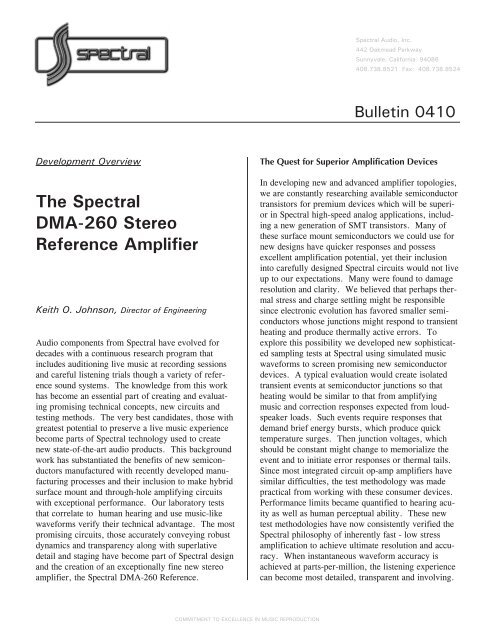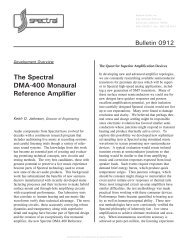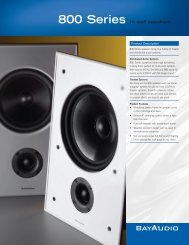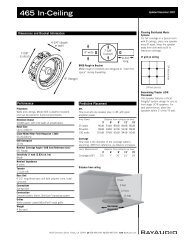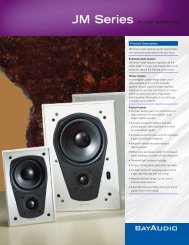The Spectral DMA-260 Stereo Reference Amplifier - Goodwin's High ...
The Spectral DMA-260 Stereo Reference Amplifier - Goodwin's High ...
The Spectral DMA-260 Stereo Reference Amplifier - Goodwin's High ...
Create successful ePaper yourself
Turn your PDF publications into a flip-book with our unique Google optimized e-Paper software.
<strong>Spectral</strong> Audio, Inc.<br />
442 Oakmead Parkway<br />
Sunnyvale, California 94086<br />
408.738.8521 Fax: 408.738.8524<br />
Bulletin 0410<br />
Development Overview<br />
<strong>The</strong> <strong>Spectral</strong><br />
<strong>DMA</strong>-<strong>260</strong> <strong>Stereo</strong><br />
<strong>Reference</strong> <strong>Amplifier</strong><br />
Keith O. Johnson, Director of Engineering<br />
Audio components from <strong>Spectral</strong> have evolved for<br />
decades with a continuous research program that<br />
includes auditioning live music at recording sessions<br />
and careful listening trials though a variety of reference<br />
sound systems. <strong>The</strong> knowledge from this work<br />
has become an essential part of creating and evaluating<br />
promising technical concepts, new circuits and<br />
testing methods. <strong>The</strong> very best candidates, those with<br />
greatest potential to preserve a live music experience<br />
become parts of <strong>Spectral</strong> technology used to create<br />
new state-of-the-art audio products. This background<br />
work has substantiated the benefits of new semiconductors<br />
manufactured with recently developed manufacturing<br />
processes and their inclusion to make hybrid<br />
surface mount and through-hole amplifying circuits<br />
with exceptional performance. Our laboratory tests<br />
that correlate to human hearing and use music-like<br />
waveforms verify their technical advantage. <strong>The</strong> most<br />
promising circuits, those accurately conveying robust<br />
dynamics and transparency along with superlative<br />
detail and staging have become part of <strong>Spectral</strong> design<br />
and the creation of an exceptionally fine new stereo<br />
amplifier, the <strong>Spectral</strong> <strong>DMA</strong>-<strong>260</strong> <strong>Reference</strong>.<br />
<strong>The</strong> Quest for Superior Amplification Devices<br />
In developing new and advanced amplifier topologies,<br />
we are constantly researching available semiconductor<br />
transistors for premium devices which will be superior<br />
in <strong>Spectral</strong> high-speed analog applications, including<br />
a new generation of SMT transistors. Many of<br />
these surface mount semiconductors we could use for<br />
new designs have quicker responses and possess<br />
excellent amplification potential, yet their inclusion<br />
into carefully designed <strong>Spectral</strong> circuits would not live<br />
up to our expectations. Many were found to damage<br />
resolution and clarity. We believed that perhaps thermal<br />
stress and charge settling might be responsible<br />
since electronic evolution has favored smaller semiconductors<br />
whose junctions might respond to transient<br />
heating and produce thermally active errors. To<br />
explore this possibility we developed new sophisticated<br />
sampling tests at <strong>Spectral</strong> using simulated music<br />
waveforms to screen promising new semiconductor<br />
devices. A typical evaluation would create isolated<br />
transient events at semiconductor junctions so that<br />
heating would be similar to that from amplifying<br />
music and correction responses expected from loudspeaker<br />
loads. Such events require responses that<br />
demand brief energy bursts, which produce quick<br />
temperature surges. <strong>The</strong>n junction voltages, which<br />
should be constant might change to memorialize the<br />
event and to initiate error responses or thermal tails.<br />
Since most integrated circuit op-amp amplifiers have<br />
similar difficulties, the test methodology was made<br />
practical from working with these consumer devices.<br />
Performance limits became quantified to hearing acuity<br />
as well as human perceptual ability. <strong>The</strong>se new<br />
test methodologies have now consistently verified the<br />
<strong>Spectral</strong> philosophy of inherently fast - low stress<br />
amplification to achieve ultimate resolution and accuracy.<br />
When instantaneous waveform accuracy is<br />
achieved at parts-per-million, the listening experience<br />
can become most detailed, transparent and involving.<br />
COMMITMENT TO EXCELLENCE IN MUSIC REPRODUCTION
Bulletin 0410 2<br />
Our search for superior amplification devices led us to<br />
recent discrete semiconductors intended for premium<br />
television and computer displays. <strong>The</strong>ir hefty construction<br />
and advanced manufacturing processes create a<br />
substantial and very fast device that is free of thermal<br />
tail and memorialization of error issues. <strong>The</strong>se new<br />
devices can operated over a wide range of voltages<br />
and currents while being capable of excellent gain<br />
linearity, quickness and ability to amplifiy very high<br />
frequencies. <strong>The</strong> <strong>DMA</strong>-<strong>260</strong> achieves its unmatched<br />
clarity and resolution from a combination of these<br />
breakthrough performances.<br />
Development of the SHHA Driver Technology<br />
In the course of development work for the <strong>DMA</strong>-<strong>260</strong>,<br />
many different semiconductor technologies and manufacturing<br />
processes have been researched. Most<br />
promising were those featuring breakthrough manufacturing<br />
processes and computed chip geometries that<br />
produced excellent tests from both traditional tone<br />
tests and our recently developed music related test<br />
methodology. Best examples from this work often<br />
spawned unique or new circuits whose design integration<br />
required computed “re-designs” that would<br />
change many resistors and capacitors in the test amplifier.<br />
Each experiment might include new JFET,<br />
CMOS or Bipolar devices, but unlike traditional parts<br />
swapping, the test platform would be a well thought<br />
out optimum design prototype that could be realistically<br />
compared to a highly evolved <strong>Spectral</strong> reference<br />
component. <strong>The</strong> result of this research effort is the<br />
<strong>Spectral</strong> <strong>High</strong>-speed Hybrid <strong>Amplifier</strong> driver module,<br />
and ideally optimised topology using the finest available<br />
transistors from both SMT and traditional leaded<br />
components technologies.<br />
In the new SHHA driver module, surface mount technologies<br />
are essential to fully utilize the new faster<br />
devices that have been successfully tested. <strong>The</strong><br />
SHHA driver module provides greater parts density<br />
where needed and its layouts have become more purposeful<br />
than our previous drivers. Exemplary staging<br />
and quiet amplification are hallmarks of this technology<br />
as left and right channels are extremely well isolated<br />
and free of interferences. Inherent miniaturization<br />
makes room for more and better support circuits used<br />
to regulate the amplifier, its voltages and currents, as<br />
well as to cancel magnetic fields and block electrostatic<br />
interactions that might propagate from signal,<br />
power and speaker cables. All <strong>Spectral</strong> amplifiers<br />
employ similar environmental isolation strategies, but<br />
additional fine-tuning from the SHHA surface mount<br />
hybrid technology greatly improves this ability. It also<br />
provides tight thermal coupling to evenly distribute<br />
temperatures allowing higher biasing currents that<br />
improve dynamic headroom. <strong>The</strong> important gain path<br />
from microvolt sensitive JFET devices to the powerful<br />
compact MOSFET output section is now direct and<br />
clean for effortless amplification. All combined, the<br />
new hybrid surface mount construction and advanced<br />
active devices of the SHHA driver improve accuracy,<br />
speed, power capability and provide greater stability<br />
margins that are necessary for supporting the <strong>DMA</strong>-<br />
<strong>260</strong> ‘Focused Array’ high-speed, high-current output.<br />
<strong>High</strong> Resolution and the Listening Experience<br />
Quick response and instantaneous accuracy to the<br />
original music waveforms of live signals are the hall<br />
mark of well crafted high resolution recordings. <strong>The</strong><br />
same requirements are necessary for their reproduction.<br />
A large inherent bandwidth that is not forced by<br />
excessive correction or feedback is an essential performance<br />
foundation as it can avoid having to confront<br />
many technical complications with negative<br />
sonic consequences. Transient intermodulation, cross<br />
modulation, group delay distortion, dispersion, reactive<br />
loading are a few of these difficult to describe and<br />
understand errors that will not be found from the<br />
<strong>DMA</strong>-<strong>260</strong>. However, thermal settling associated with<br />
quickness (thermal tails) could have been an issue as it<br />
is with most fast circuits. Advanced testing and stateof-the-art<br />
semiconductors, exceptional layouts with<br />
much dedicated engineering has been necessary to<br />
address and eliminate these distortion issues. In a<br />
waveform or time sense, the output signal from the<br />
<strong>DMA</strong>-<strong>260</strong> traverses from point “A” to “B” of a musical<br />
event with exactly the same waveform shape as its<br />
input signal. It does this with parts-per-million accuracy<br />
that is free of memorialized unnatural artifacts<br />
either before or after the input event. This requires
Bulletin 0410 3<br />
extreme precision. Because <strong>Spectral</strong> circuits have<br />
intrinsic speed and acccuracy, the amplification<br />
from the <strong>DMA</strong>-<strong>260</strong> is stress free and precise and<br />
this important performance aspect preserves clarity,<br />
transparency and resolution.<br />
<strong>The</strong> <strong>DMA</strong>-<strong>260</strong> Optimized System<br />
Circuits, devices, layouts and construction aspects<br />
of <strong>Spectral</strong> amplifiers are carefully engineered and<br />
structured to work together as a system capable of<br />
producing a highly refined level of performance.<br />
All assemblies and most components inside the<br />
<strong>DMA</strong>-<strong>260</strong> are revised and improved or have had<br />
upgrades to fully realize the virtues of the new<br />
SHHA driver board. <strong>The</strong>se improvements are necessary<br />
to fulfill the <strong>Spectral</strong> uncompromised design<br />
philosophy.<br />
Along with the innovative new SHHA driver section<br />
the <strong>DMA</strong>-<strong>260</strong> feature new power supply design and<br />
transformers. <strong>The</strong>se larger transformers have the<br />
tightest regulation and precision we have yet<br />
achieved, with the ability to energize even tougher<br />
loads. Remarkable, this greater performance can<br />
still be met in a amplifier of relatively modest size<br />
and weight.<br />
<strong>The</strong> Result: Instantaneous <strong>Amplifier</strong> Accuracy<br />
In the <strong>DMA</strong>-<strong>260</strong>, <strong>Spectral</strong> introduces the SHHA<br />
driver technology, a radically improved amplifier<br />
topology featuring double the speed and signal<br />
response of our previous drivers. At these elevated<br />
speeds, device energy storage and thermal memory<br />
can now be observed as significant signal distortion,<br />
bluring transient detail and smearing instrument<br />
decay and interplay. Sophisticated new testing methodology<br />
identifies these fast-moving, thermal tail<br />
artifacts and directs their elimination in the advanced<br />
new SHHA driver topology. Combined with the<br />
redesigned ‘Focused Array’ output section, the new<br />
SHHA driver achieves parts-per-million waveform<br />
accuracy and the lowest distortion levels attained in<br />
an audio amplifier. <strong>The</strong> long sought after ideal of<br />
‘instantaneous accuracy’ with virtually no signal<br />
memory is significantly realized in the <strong>DMA</strong>-<strong>260</strong><br />
<strong>Stereo</strong> <strong>Reference</strong> amplifier.<br />
An array of systemboard revisions including new<br />
driver supplies and improved output filter capacitors<br />
have reduced high frequency losses to improve transient<br />
blocking. <strong>The</strong>se changes improve noise propagation<br />
and create a perfect match to the speed capability<br />
of the ultra-fast SHHA driver module.<br />
All new signal cables and grounding system are<br />
designed to exploit the higher isolation capacity of<br />
the new SHHA driver and power supply systems.<br />
Audio paths are shorter and more direct with less<br />
RF filtering for lowest possible noise and extreme<br />
quiet signal resolution.


